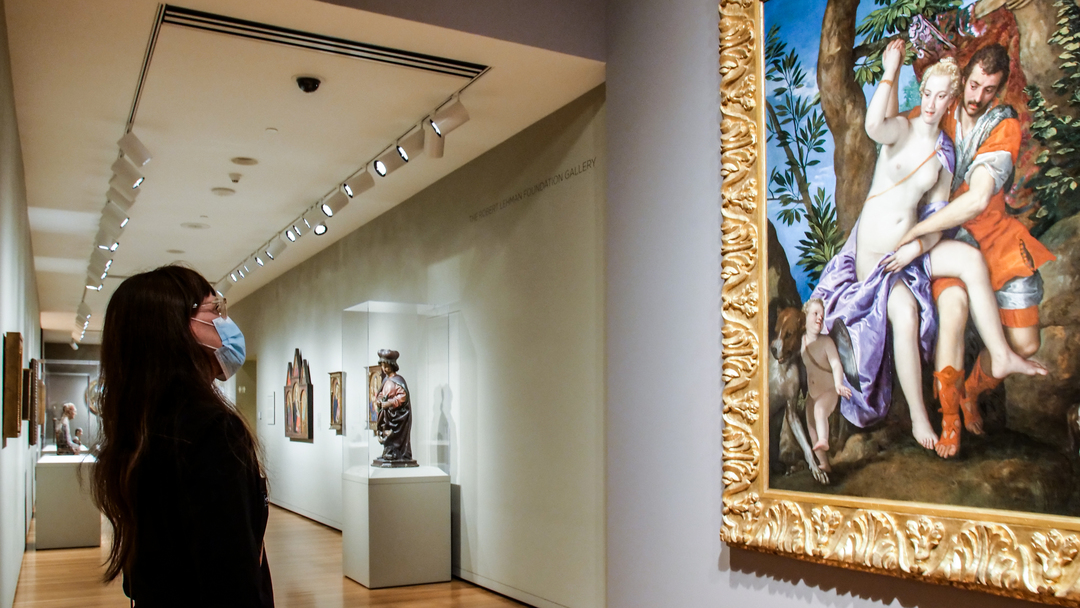Muse/News: Accessible Museums, Black Legacies, and Benin Treasures
SAM News
The Seattle Times reporter Grace Gorenflo and photojournalist Alan Berner checked out SAM’s recent first-ever mask-required hour, speaking with museum visitors about why the offering appealed to them. The museum no longer requires masks for entry, but visitors are encouraged to wear them for their personal safety and comfort–and the next mask-required hours are scheduled for the third Saturdays of June and July.
“‘Accessibility and inclusivity are important goals for SAM,’ [Chief Marketing Officer Mikhael] Mei Williams said. ‘This was something that we wanted to do to make sure that we could give as many people as possible access to the museum.’”
“[Visitor Melissa] Rothe said that more places that are prone to crowds could benefit from a mask-required hour, and her family would visit any museum that institutes something similar. Her son Ethan, 12, seconded that, saying the mask-required hour makes him feel safer when visiting museums, which he enjoys doing. ‘I just like looking at all the cool stuff that people have built in the past and things that have happened before us,’ he said.”
Thrillist shares a list of “21 Actually Cool Things to Do in Seattle This Summer”; it is an actually pretty cool list, including the recommendation to “get cultured” at SAM.
The Seattle Times’ Pacific NW Magazine takes a look at the stories behind the official state symbols, including some throwback photographs connected to Middle Fork at SAM and the state tree, the Western Hemlock. The massive sculpture by John Grade that spans the museum’s Brotman Forum entrance lobby was photographed twice by Alan Berner: in 2015, when the artist and his team went into the sky to cast an old-growth hemlock, and in 2018 as visitors gazed up at the final sculpture.
Local News
The Seattle Times’ Jerald Pierce features apprentices and teachers of Washington State’s Heritage Arts Apprenticeship Program, a partnership between Humanities Washington and ArtsWA/Washington State Arts Commission.
“A Water Goddess at the International Arrivals Facility”: The Stranger’s Jas Keimig on Marela Zacarías’s sculpture Chalchiuhtlicue at Sea-Tac. Oh hey: they have a redesigned website to explore, too!
Dive into Crosscut’s Black Arts Legacies project, which “highlights the longstanding, vital and ongoing role of Black artists and Black arts organizations in the cultural landscape of the Seattle region.” Created by many local Black storytellers, including project editors Kemi Adeyemi and Jasmine Jamillah Mahmoud, the project includes written, video, and podcast stories and conversations.
“We are recognizing an intergenerational group of 26 local musicians, dancers, visual artists, poets, performers, curators and architects, whose creative expressions document the complexity of being a Black artist in Seattle. Theirs are stories of being the first, of contending with discrimination and breaking down barriers, of long careers and careers cut short, and of building community through the arts.”
Inter/National News
“It Feels Right to Grieve With My Hands”: As part of the collaboration between Artnet and Art21, watch sculptor Heidi Lau work on her clay mourning vessels.
Anthony Ham for Smithsonian Magazine on Papunya Tula, the Australian Aboriginal desert art movement celebrating 50 years. SAM has its own celebration for the artists in its third floor galleries–don’t miss it!
Peggy McGlone for the Washington Post on the continued conversations around US museums returning Benin treasures. SAM was the first to register its works with the Digital Benin Project referenced in the article, and in our fourth floor galleries is a small installation, Benin Art: Collecting Concerns, bringing attention to the works in SAM’s collection and to our efforts to work with the Kingdom of Benin.
“Most significantly, the lessons of the Benins have changed museums’ attitudes toward repatriation, making it less contentious and more commonplace. And that will be its lasting contribution to the field, experts say. ‘These are low-hanging fruit. This is a clear-cut case of these objects must be returned,’ RISD Museum chief curator Gina Borromeo said of the Benin bronzes. ‘There are more complicated issues that need to be addressed in African art, and really in art created in the Global South. It is important that we continue to think about these issues and keep shining a light on them.’”
And Finally
Definitely don’t smear the Mona Lisa with cake.
– Rachel Eggers, SAM Associate Director of Public Relations
Image: L Fried.
